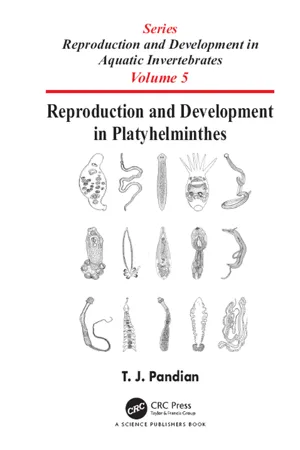
- 306 pages
- English
- ePUB (mobile friendly)
- Available on iOS & Android
Reproduction and Development in Platyhelminthes
About this book
This book is a comprehensive elucidation on aspects of reproduction and development in platyhelminthes covering from acoelids to taeniids. With the unique presence of neoblasts, turbellarians serve as a model for studies on cancer and senescence. Of ~ 27,000 species, ~ 77% are parasites; they are harmful to man and his food basket from livestock and fish. The stress hormone, cortisol level is responsible for susceptibility and resistance of the host. In digeneans, the propagatory multiplication potency is retained by all the larval forms and in either direction in sporocyst. The higher clonal diversity, mixing and selection in Second Intermediate Host (SIH) may purge inbreeding depression suffered by the fluke on propagatory multiplication in First Intermediate Host (FIH). Of 12,012 digeneans, 88% may engage 33,014 potential SIH species. They have the choice to select one among the available/awaiting 3.5 host species. The motility of vertebrate host and euryxenic flexibility/scope for selection of SIH species has increased lineage diversification in digeneans. The life cycle of cestodes is divided into aquatic and terrestrial patterns. The former includes (i) oncosphere and (ii) coracidium types and the latter (iii) hexacanth-cysticercoid, (iv) hexacanth-tetrathyridium and (v) hexacanth-cysticercus types. The share for the oncosphere, coracidium and hexacanth types is 17.0, 29.5 and 46.5%, respectively. The staggering fecundity and adoption of the intermediate host in the herbivorous/insectivorous food chain have enriched Taenioidea as the most (2,264) speciose order. Sex specific genes Smed-dmd 1 and macbol have been identified, and neuropeptides and dipeptides are involved in sexualization. Trematodes are unable to parasitize elasmobranchs, as they cannot suck body fluid/blood containing a high level of urea. Relatively higher fecundity supplemented with propagatory multiplication, incorporation of SIH in 88% species, clonal selection in SIH, and euryxenic flexibility and the widest choice for selection of SIH have led to the highest lineage diversification to render digeneans as the most speciose order in Platyhelminthes.
Frequently asked questions
- Essential is ideal for learners and professionals who enjoy exploring a wide range of subjects. Access the Essential Library with 800,000+ trusted titles and best-sellers across business, personal growth, and the humanities. Includes unlimited reading time and Standard Read Aloud voice.
- Complete: Perfect for advanced learners and researchers needing full, unrestricted access. Unlock 1.4M+ books across hundreds of subjects, including academic and specialized titles. The Complete Plan also includes advanced features like Premium Read Aloud and Research Assistant.
Please note we cannot support devices running on iOS 13 and Android 7 or earlier. Learn more about using the app.
Information
1
General Introduction
Introduction

A. Ectocommensalic acoelid Ectocotyle paguri (after E.G. Richard), B. rhabdocoel Microstomum, C. Dugesia tigrina (from Hyman, 1951), D. Temnocephala (after Haswell, 1893), E. Land planarian Bipalium kewense and F. Polystomoides (after Stunkard, 1917). G. Rajonchocotyle (after Muller and Van Cleave, 1932), H. Opisthorchis sinensis (after A.E. Galigher), I. Diplostomum (after Dubois, 1938), J. Schistosoma haematobium (after Looss, 1990). K. Lithobium aenigmaticum (from Caira et al., 2014), L. Taenia (after Olsen, 1939), M. Echinococcus granulosus (after Southwell, 1930), N. Gyrocotyle and O. T. saginata (from Hyman, 1951) (All figures are free hand drawings).
Disease | Host | Country | Reported observations | Reference |
|---|---|---|---|---|
Incidence | ||||
Schistosomiasis | Human | 200 mil infected, 0.2 mil die | see Pandian (2017) | |
Fasciolosis | Cattle | Global | 1.7 mil bovines infected | |
Human | Global | 35 mil people infected, especially in the Chinese countries | Lim (2011) | |
Cattle | India | 30–80% incidence | Gupta and Singh (2002) | |
Helminths | Human Poultry | Global Egypt | 40 mil infected 14% (geese), 38% (ducks), 42% (turkeys), 46% (fowls) and 52% pigeons are infected | A. Payne (Facebook) Nagwa et al. (2013) |
Cost and Loss | ||||
Fasciolosis | Human | USA | Costs 100 mil US$/y | Roberts et al. (1994) |
Sheep | Ethiopia | Loss amounts to 114,678 $/y | Ayalneh et al. (2018) | |
Sheep & Goats | Global Australia | Loss is 2.5 bil €/y Loss is 50–80 mil €/y | Love (2017) Boray (2007) | |
Cattle | Ethiopia | Infected liver condemnation costs 8312 $/y | Abebe et al. (2010) | |
Cattle | Switzerland | Loss @ 299 €/infected cattle/y costs 50 mil €/y | Dorchies (2007), Schweizer et al. (2005) | |
Cattle | England | Loss is 23 mil £/y | Mazeri et al. (2016) | |
Cattle | USA | Loss is 5 mil US$/y | Malone (1986) | |
Cattle | Uttarkhand, India | 900 mil Rs/y on milk yield alone in a small state | Bardhan et al. (2014) | |
Cattle | India | Estimated loss is 4.86 bil/y | McCusker et al. (2016) | |
Taeniasis Cysticercosis | Human Human | USA USA | Cost 0.3 mil $/y with lowest (0.06%) Incidence. cf 12% incidence in Laos 7% incidence costing 0.8 mil $/y | Roberts et al. (1994) Roberts et al. (1994) |
Parasites | Fishes | Global Brazil | Loss is 84 mil $/y Loss is 5 mil $/y | Tavares-Dias and Martins (2017), Shinn et al. (2015) |
1.1 Taxonomy and Diversity
Table of contents
- Cover
- Title Page
- Copyright Page
- Preface to the Series
- Preface
- Acknowledgements
- Table of Contents
- 1. General Introduction
- 2. Turbellaria
- 3. Monogenea
- 4. Digenea
- 5. Cestoda
- 6. Sexualization
- 7. Comparison and Highlights
- 8. References
- Author Index
- Species Index
- Subject Index
- Author’s Biography